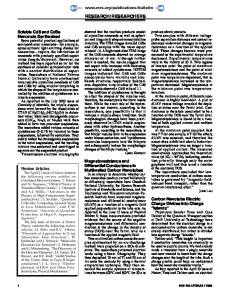Preparation and Application of Chitosan-Grafted Multiwalled Carbon Nanotubes in Matrix Solid-Phase Dispersion Extraction
- PDF / 586,136 Bytes
- 9 Pages / 595.276 x 790.866 pts Page_size
- 46 Downloads / 364 Views
Preparation and Application of Chitosan-Grafted Multiwalled Carbon Nanotubes in Matrix Solid-Phase Dispersion Extraction for Determination of Trace Acrylamide in Foods Through High-Performance Liquid Chromatography Handong Zhao & Ningyang Li & Jinwang Li & Xuguang Qiao & Zhixiang Xu
Received: 11 August 2014 / Accepted: 7 October 2014 # Springer Science+Business Media New York 2014
Abstract In this study, chitosan-grafted multiwalled carbon nanotubes were synthesized and characterized using Fourier transform infrared spectroscopy, transmission electron microscopy, X-ray diffraction, thermogravimetric analysis, and static and kinetic adsorption experiments. The results showed that the resulting material had good adsorption abilities and rapid dynamic properties for acrylamide. This material was used as a sorbent for development of matrix solid-phase dispersion extraction coupled with high-performance liquid chromatography for the determination of trace acrylamide in foods. Under the optimal conditions, the limit of detection, based on three times the signal to noise ratio of the baseline near the analyte peak, was 1.5 μg/L, and the relative standard deviation for five replicate extractions of 50 μg/L acrylamide was 4.3 %. Blank potato and flour samples spiked with acrylamide at different levels, namely, 2.25, 4.50, and 6.75 μg/kg, were extracted and determined by the developed method, with good recoveries ranging from 85.3 to 94.6 %. This method was used for quantitative analysis of acrylamide in different food samples, including twisted cruller, potato chip, and toast samples. Compared with other methods, this method for the extraction and determination of trace acrylamide in food samples is rapid and simple. Keywords Acrylamide . Chitosan-grafted multiwalled carbon nanotubes . Matrix solid-phase dispersion extraction . High-performance liquid chromatography
Ningyang Li contributed equally to this work. H. Zhao : N. Li : J. Li : X. Qiao : Z. Xu (*) College of Food Science and Engineering, Shandong Agricultural University, Tai’an 271018, People’s Republic of China e-mail: [email protected]
Introduction Since the Swedish National Food Administration and researchers at Stockholm University first announced, in April 2002, that high levels of acrylamide had been found in foods such as French fries and bread (Tareke et al. 2002), acrylamide has become a priority human health issue and attracted worldwide concern, because of its demonstrated neurotoxicity, genetoxicity, and reproductive development toxicity (Costa et al. 1991; IARC 1994). As a heat-induced food contaminant, it is probably carcinogenic to humans (Wenzl et al. 2007). Acrylamide is usually produced in starch-rich foodstuffs via the Maillard reaction at temperatures above 120 °C, especially at 140–180 °C (Fernandes and Soares 2007; Mottram et al. 2002). It is therefore necessary to control acrylamide production during food-heating processing to protect human health. Many methods, including gas chromatography (GC) and liquid chromatography (LC), have been
Data Loading...











